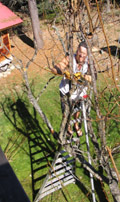Orchard Almanac
Mark DuPont,
Sandy Bar Nursery
Fertilizing Fruit & Nut Trees
Fertilizing trees too much can be even more harmful than not fertilizing at all. How do you know when enough is enough?
Research & experience shows that excess fertilization of fruit & nut trees can result in too much rank, vegetative growth, reduced bloom & fruit set, reduced quality of fruit, & diseases such as fire blight, brown rot & powdery mildew. Excess nitrogen creates a nutrient imbalance in the plant, which results in weakened cell structure in the leaves & branches and high nitrates and low sugars in the fruit. That means the foliage is susceptible to disease and the fruit lacks flavor and does not store well. On the other hand, Nitrogen deficiency results in weak growth and yellow foliage.
Balance is the Key
The key to proper fertilization is a balance of
nutrients. Nitrogen & Potassium are necessary for plant growth, and
especially important in a tree’s formative years when you want to establish
a strong scaffold of branches to bear the many years of abundant harvests.
Phosphorous is essential for disease resistance and flower & fruit
development. A common error of many backyard gardeners is to go too heavy
on nitrogen (in the form of chemical fertilizers or raw manures) and neglect
Phosphorous & Potassium as well as other essential nutrients.
Plant Analysis
One of the best indicators of a soil fertility & tree health is reading the annual growth of the tree itself. Look closely at the branches on your fruit tree. If you follow the branch back from the tip you’ll see a clearly defined ring marking last year’s growth (or you’ll see the present season’s pruning cut). By continuing backwards down the tree you can read how much a tree grew the previous season and how it responded to the previous year’s pruning cuts. As a rule of thumb you want to see 6 to 18 inches of growth per year on mature trees in the home orchard (younger trees grow more vigorously and should put on more growth). If your mature trees are meeting the growth parameters then your have adequate fertility in your soil, and adding more nitrogen may be detrimental. If you are not meeting the recommended annual growth will need to fertilizer. We prefer using composted manures as they are a balanced fertilizer, including all of the essential plant nutrients, not just Nitrogen.
Cover Crops - Why Haul All that Manure Around?
Planting a perennial cover crop of mixed grasses, legumes and herbs is an excellent way to provide long-term fertility for your fruit & nut trees. Once established a perennial cover crop will provide nitrogen, attract beneficial insects and cycle nutrients, all to the benefit of your orchard-garden ecosystem. We recommend planting a mix of legumes and grasses, with some tap root plants, such as parsley, dandelion, daikon radish, beets, carrots chicory. For More information on cover crops, ATTRA (Appropriate Technology Transfer for Rural Areas) has a great online pamphlet on cover crops at http://www.attra.org/attra-pub/covercrop.html - principle
i’ve Planted My Fruit Trees, What
Next?
Paint Your Tree Trunks! – Young tree trunks are susceptible to sunburn and should be protected with a whitewash. Use a white or light colored water-base latex paint diluted 50% with water. Paint the trees solid up to the first branches (or where you want the first branches to be, if you planted a whip). Paint around rather than over the buds that you want to sprout – the whitewash will delay and inhibit bud break.

Water Consistently - The number one cause of fruit tree failure is lack of water. Sufficient water is especially critical in the first season. A general rule of thumb, it is best to water infrequently and deeply. The best way to ensure consistent watering is by using a drip system. Drip system components are available in most gardening centers. Your can find just about attachment to suit your style, from sprayers to soakers to drippers to misters. If you’re not familiar with drip then the wide array of gizmos can be baffling, so read up on it find a good salesperson who knows what he/she is talking about. There is a great book: Drip Irrigation for Every Landscape and All Climates, by Robert Kourick, which is very practical and well written.
Fruit Tree Information on the Web – There is wealth of information on fruit trees on the web. If you haven’t visited our website page lately, be sure to check out the updated information links which will bring you to sites on fruit tree culture, pest management, plant databases & more – http://www.sandybarnursery.com/
Enjoy the Spring!